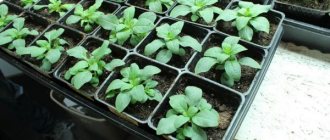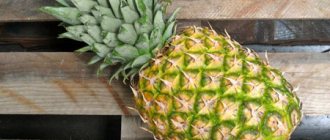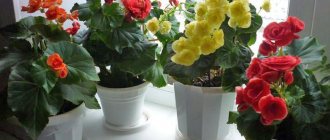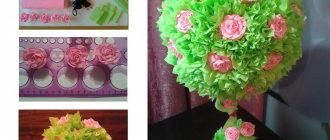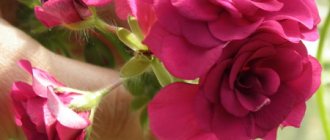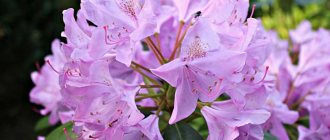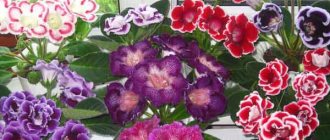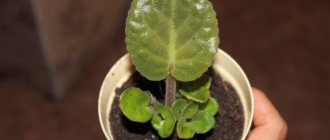Many people consider gloxinia to be a rather capricious plant, but this is not so. It doesn’t have many growing requirements, and it also reproduces easily.
- History of Gloxinia
- Features of growing gloxinia or sinningia
- Classification of Gloxinia by size
- By color
- dividing tubers
History of Gloxinia
Already at the end of the 18th century, the South American plant Gloxinia, named after the famous naturalist Peter Gloxinia, won the hearts of European collectors. Later in England, the Brazilian specimen was thoroughly studied, assigned to the Gesneriev family and officially named Sinningia - in honor of the scientist Wilhelm Sinning. And so it has been since then: in scientific circles it is called Sinningia, among the people - Gloxinia.
Similar flowers
- Violet - the plant belongs to the violet family. Grows mainly in regions with temperate climates. Terry gloxinia is a beautiful indoor plant that attracts with its large flowers. There are about 70 species of this plant.
- Gloxinia Avante white - belongs to the terry section. The shape resembles a camellia or a garden rose.
- Gloxinia Yesenia is a double Dutch hybrid. Reaches 30 cm in height and is a cultivated plant in the world.
- Gloxinia Prince Albert is a simple gloxinia variety with showy flowers. It has additional grace in the form of wavy edges.
Gloxinia is undoubtedly a beautiful flower. Growing it is not as easy as we would like, but it is worth it. Not a single guest will pass by without paying a single compliment to such beauty!
Classification of Gloxinia
To size
❀ Standard gloxinia: a rosette with a diameter of 25–40 cm. One of the largest synningias was about 60 cm in diameter and had about 100 flowers that bloomed at the same time! The diameter of the pot is 10–20 cm.
❀ Compact cloxinia: rosette diameter 15–25 cm, can produce up to 50 buds on one plant. The diameter of the pot is 10–15 cm.
❀ Miniature and microminiature gloxinia: diameter from 5 to 15 cm (gloxinia varieties Colorado Sunset, Ozark First Born). The diameter of the pot is 6–8 cm.
In catalogs you can see the definition of “semi-miniature” gloxinia: most likely, this is a way to emphasize the compactness of the rosette, by analogy with Saintpaulias.
1 photo - Gloxinia Pink Fairy Tale. 2. photo - gloxinia tidea violet, 3. photo - gloxinia Tigrina red
By color
❀ The color range of synningias is varied: flowers are found in white, lavender, red, purple, with tints and transitions. The varieties with specks, a multi-colored halo or a light yellow throat, with a contrasting border (they are conventionally called tigrina) are unusually beautiful.
Gloxinia Cherry
❀ There are “calico” (covered with specks of one or several colors), single-color and two-color varieties.
❀ Based on the shape of the flowers, there are simple (one row of petals, usually 5-8 pieces) and double (more than one row of petals) varieties.
general information
Gloxinia is an indoor flower. Otherwise it is called sinningia. This is a herbaceous perennial plant. It has rhizomes in the form of tubers and is a representative of the Gesneriaceae family.
The leaves are velvety, grow in breadth, and are moderately thick. The leaves give off a pleasant, delicate scent. Gloxinia has very beautiful flowers. Each flower looks like bells or shoes. They are located on peduncles of different lengths. Flowers come in a wide range of shades. Color may vary.
For example, it can be white, pink, lilac, red, etc. Among all the variety of plants, there are simple varieties, terry ones. Along the edges of the flowers there is a border, a neat frill. The surface inside is strewn with specks of a darker or lighter color. The flowering period usually occurs in March and April.
In order for people to express their feelings, the language of flowers was invented in eastern countries. The meaning of gloxinia is love that occurs at first sight. Therefore, the plant is used as a kind of love talisman that brings peace and harmony to relationships.
The plant has an unusual ability. It helps in relieving fatigue and tension in a person who has been engaged in monotonous physical or mental work for a long time.
Its varieties are incredible in their coloring. The catalog, which presents all the options, can be seen on the website of Svyatoslav Siletsky. He collected all the specimens, even the plants that breeders came up with in 2015.
Substrate for gloxinia
The soil should be breathable, but at the same time sufficiently nutritious. Approximate composition: leaf humus, high-moor peat, baking powder (perlite) in a ratio of 2:4:1. It is advisable to add superphosphate - 1 tsp. per 10 liters of soil. If the peat is fibrous and light, raising agents are not needed.
When growing with wick irrigation, when water or nutrient solution from the container rises along the cord, more raising agents are added to provide the roots with enough oxygen.
Know-how from the Nevsky House of Violets: to retain moisture, add 0.5 parts of Seramis clay granulate to the substrate.
Other color palette
Gloxinia Crispa Meteor stands out among all other relatives with its rich red color in the center of the bell, and the edges, on the contrary, are light. The flowers are large, up to 9 cm in diameter. When blooming, it forms a real bouquet of 20 bells framed by velvety dark green leaves. The height of gloxinia is from 15 to 25 cm. It belongs to the compact group. Quiet time November-February. Healthy tubers are needed for reproduction.
In Terry, on a fairly long peduncle, surrounded by dark green leaves, up to two dozen large bells the color of ripe raspberries appear during the summer, but specks of beetroot appear. The plant belongs to the standard group. The hybrid gloxinia variety Avanti scarlet - during the flowering season there can be up to twenty large, rich red gramophones, up to 8 centimeters in size, at the same time. This semi-double hybrid belongs to the compact group. It blooms earlier than all other relatives. On the amazing blue and white hybrid, the flowers do not stop blooming from spring to autumn. The color transition from blue at the edges to intense purple towards the center is surprising. But what attracts most attention is the snow-white edge along the edge of the petals. 10-30 of these beauties bloom on a plant at one time. Gloxinia is compact, the leaves are small, light green. Gloxinia Kaiser Wilhelm stands out with its rich black-violet or blue bells, the size of which reaches 8-9 cm in diameter. The border and the bell itself are white on the outside. The border of the strip is clearly visible. The neck is dark, if you look closely you can see specks. Flowers last a long time and do not lose their charm. Plant height 25-30 cm is a standard group. Unlike its counterparts, it gives the first bells at the 3rd or 4th year. Brocade is one of the hybrids that the Japanese gave to the world. There are two colors: with plain blue and red petals; with red, pink with a pronounced white border. The peduncle is stable, not too tall. At the age of two years, Gloxinia immediately blooms about 25 huge bells, which look like a huge multi-colored ball among the small velvety green leaves. Flowers are located close to each other. Refers to compact, low-growing indoor plants.
You can find out more about the varietal diversity of gloxinias and new species in the collection on Svyatoslav Sinetsky’s website. He has been passionate about flowers for many years.
Read about reproduction and care
Conclusion
According to astrological research, gloxinia belongs to the sign of Taurus. If there is such a flower in the house, then the energy is always clean and has a beneficial effect on the human psyche. After all, a plant with beautiful gramophones is neither a vampire nor a donor. These are neutral flowers. Therefore, they can be kept in any room of the apartment.
Gloxinia lighting
Sinningias are suitable for any side of the window, except the south, and a place protected from drafts. Whether a plant is properly lit can be determined by its external signs.
❀ If there is enough light: the plant is compact, the leaf petioles are short, the leaves do not stretch upward, the rosette is symmetrical, the flowers are fully open.
❀ If there is not enough light: the trunk lengthens, the rosette folds the leaves, the color of the leaves is pale and unsaturated, the leaf blades are thin, the peduncles are long and drooping, the flowers are poorly
❀ If there is too much light: light spots appear on the foliage, the leaves are hard and the rosette is “thickened”, the leaves do not straighten out, the flower stalks cannot get out from under the leaves. It is necessary to shade the plants with parchment paper attached to the glass or hang blinds.
❀ To grow gloxinia on a shelf, 12–14 hours of lighting is required. If the lamps are new, they emit brighter light - this must be taken into account. Good results are achieved by growing under Osram Lumilux Daylight 865 and Osram Fluora or Osram Natura lamps. The distance from the socket to the lamp should be 18–30 cm.
Gloxinia, or Sinningia
Terry splendor
Gloxinia Zaznoba looks very attractive. Its double flowers have a large diameter and are white in color. The petals are covered with peas of a violet-purple hue, there is a lilac border with a violet tint. The variety is characterized by compact bushes.
Gloxinia Moon Shadow is a double variety, endowed with huge flowers. The petals have a wide purple frame; white inclusions add unusualness and tenderness to the flower. Among connoisseurs and professionals, the variety is recognized as a masterpiece.
Gloxinia Winter Cherry is similar in appearance to the previous variety, but its petals are decorated with small peas that play in burgundy and purple colors. The bushes look very beautiful in pots on window sills; the decorative effect is emphasized by a compact, neat bush with short peduncles.
Gloxinia Cleopatra is a double variety. An inexperienced person will not immediately be able to distinguish it from the Winter Cherry variety, which is due to its external identity.
One of the most beautiful terry varieties is the Milky Way variety. It immediately amazes with its luxury, unusualness and grandeur. The diameter of the flowers is very large. On the white petals there are specks (violet, lilac), along the edges the colors are less bright, which adds sophistication. The leaves are endowed with a silvery vein, the base of the leaf itself is light green. The peduncles of this variety are of medium length, but this does not reduce its visual appeal.
Varieties with unusual or solemn names are especially popular. For example, Gloxinia Calico Wedding. It can be presented to spouses as a symbolic anniversary gift. On the white background of the petals there are specks of lilac color. There is a thin rim at the edges (the specks there are very thick, the color is lilac). Terry Sudarushka is distinguished by its romance and playfulness. Medium-sized polka dots are clearly visible on the white petals. Their color is red with a pink tint. Sudarushka has strong peduncles and compact bushes.
The Pani Valevskaya variety is distinguished by its extraordinary decorative properties. The main color of the flowers is white, they are double. The border stands out clearly against the white background, as it itself is crimson-red. Compact bushes have small but strong peduncles.
Gloxinia Crimson Study has a red frame around the edges. On the petals you can see not only dark red polka dots, but also streaks, which adds exoticism. The peduncles of this variety are long.
Gloxinia Charm captivates with the contrast of a delicate terry white base and a rich pink frame around the edges. Bright pink peas are randomly placed throughout the flower. The flower stalks are medium-length and particularly strong; the bushes are neat and compact.
Humidity and watering of gloxinia
Recommended air humidity is not lower than 20%. With insufficient humidity, the rosette and leaves become smaller, the tips of the leaves dry out, the buds do not open and dry out.
The leaves of Sinningia are pubescent, so they are not sprayed, but washed to remove dust under running warm water, removing excess moisture with a paper towel. Do not place the rosette in the light until it dries completely, otherwise the drops in direct sunlight will cause a burn on the leaves.
Water the plants after the top layer of soil has completely dried - in the morning, without getting on the leaves, evenly wetting the soil. It is better not to water them in the evening, as the temperature will drop at night and there is a risk of rotting of the roots and tubers.
It is possible to water both from above and into the pan, but then the drainage must conduct water. Synthetic winterizer is excellent: it is chemically neutral and conducts water and air; many use sphagnum moss as drainage.
When planting, you can stretch a synthetic thread - a wick 0.2-0.4 cm thick - through the holes in the bottom of the pot; along it, moisture will rise into the soil, and it will be better wetted.
Water for irrigation is used at room temperature. If fertilizers are applied during watering, the temperature should be several degrees higher - this way the nutrients will be better absorbed.
Some important subtleties
Since the homeland of gloxinia is warm South America, this plant requires a little more attention than any other house flower familiar to our climate. Although numerous hybrid indoor varieties are still less whimsical and capricious. You should also remember that this plant is seasonal, and do not be alarmed if, after flowering ends, your new plant suddenly drops its leaves and withers. You just need to preserve the dormant tuber until spring, and again wait for the appearance of bright buds and lush greenery.
If you decide to give the interior of your home or office a pleasing multi-colored decoration, then compact and very impressive indoor gloxinias will be a very good choice. In addition to aesthetic splendor, they are able to fill the room with an exquisite, pleasant aroma.
Temperature for gloxinia
Optimal air temperature is +18…+23 °C. The plant can withstand +30 °C, but this will become a strong stress for it, loss of turgor or blackening of leaves, rotting of roots is possible. If this does happen, you need to root the leaf just in case, check the condition of the tuber: remove it from the pot, free it from dead roots, plant it again and monitor watering.
Diameter of the pot It should not be much larger than the tuber (3-4 times). In large pots, moisture stagnates, roots develop poorly and the tuber may rot. Conversely, in a pot that is too small, the earthen ball dries out quickly and the growth of the plant slows down. It's better to use plastic ones.
You cannot plant several tubers in one pot.
Interesting options
Gloxinia Madonna is popular for its color. Madonna flowers have a certain lacy airiness; they are white, and their middle is yellow or even lemon. The petals have a fringe, which visually makes the volume of the flower even larger. The stem on which the inflorescences are located. quite tall, it bears large leaves, the color of which is presented in light green tones. Flower growers note that Madonna is quite easy to propagate and is well accepted.
Gloxinia terry white has rather large flowers, the neck of which is colored green and lemon. The leaves are green with an emerald tint, the stem is characterized by high strength, but it is not very tall. The bushes are characterized by a high level of compactness.
Rose peach is a double gloxinia, which is painted in delicate shades of pink. In the central part of the petal there is a rather wide but blurred stripe. Its color is dark pink, but there are types with a softer palette in the center. Small white dots can be seen in the throat of the flower. The stem on which the flowers are placed is low. Sometimes there are flowers that are painted white, and their central part is pink.
The Snow Queen is a representative of terry gloxinias. Its flowers are quite large. The middle of the flower is purple and the rest of the petal is white. Although flower growers have options with a lilac color, which can be obtained through certain plant care technologies. The edges of the petals of such a plant are framed by a lilac line. The bushes are compact.
Gloxinia Constellation of Love is a bright double flower, which is bordered by a burgundy edge. The throat is painted in light, practical white tones. The petals are not very large, the stems are strong. Unpretentious in care.
Fertilizers for gloxinia
Sinningia should be fertilized a month and a half after planting. Flowering is promoted by mineral fertilizers with a high content of phosphorus and potassium; nitrogen and microelements are required for active growth. Phosphorus fertilizers are used to feed already grown plants that are ready to flower, otherwise their growth will slow down.
Fertilize during the growth and flowering period every two weeks, alternating mineral and organic fertilizers. Foliar fertilizing with vermicompost infusion (according to the instructions) gives excellent results - it is sprayed on the upper and lower surfaces of the leaves in the afternoon, when it gets cooler. If rotted manure is added during planting, you should avoid fertilizing with liquid organic fertilizers.
Winter “sleep” and storage of gloxinia tubers in winter
At the end of November, with decreasing daylight hours, Sinningia stops blooming and gradually dries out. After the above-ground part dies, the tubers are dried at room temperature and placed for winter storage in a dark and cool place, but not in the refrigerator. The best temperature for storage is +10...+16 °C; at a lower temperature the tuber can freeze, at a higher temperature it can “wake up”. To save space, you can store the tubers in a zip bag.
All collectors have different storage methods: wrapped in a napkin, in vermiculite, in coconut substrate, peat, Seramis granules and even in sawdust. You can store the tubers in pots, but make sure that the soil does not dry out and water them with water at room temperature at least once a month, otherwise they will dry out and die.
Twice a month they check the condition of the tubers and make sure that condensation does not settle on the bags. The dormant period lasts about 3 months depending on storage temperature.
Most common types
Gloxinia Royal is one of the most popular and frequently encountered representatives. Its peculiarity is its small height (up to 10 cm), but the plant has strong shoots. They contain about 12 leaves, and they usually stand in pairs. The leaves themselves are quite large and can reach 20 cm in length. They have an interesting shape, resembling an oval. They are also characterized by a specific green color. The flowers have a dark purple color, they are quite large, since their diameter is on average 7 cm. They are pleasing to the eye in the summer.
The beautiful Gloxinia resembles the Royal one in appearance. The leaves of the plant have a slightly different color, since their shade is somewhat lighter. In addition, its leaves do not have silver veins. The beautiful Gloxinia has large flowers. They are most often purple, but purple variants may also occur.
Yesenia is popular among flower growers due to the fact that its flowers are double, and this looks very attractive from the outside. Their color is usually burgundy or beetroot. The flowers on the bush are placed abundantly, and the bush itself is compact. The leaves on the outside resemble velvet.
Planting gloxinia tubers
When sprouts appear on the tuber (no more than 1 cm), this means that it has “woke up” and is ready for planting. You can speed up the awakening by placing it in a zip bag with the addition of a small amount of peat, in a warm, bright place. To stimulate awakening, you can soak the tuber before planting in a solution of Epin or Zircon.
The tuber is cleaned of dead roots and tissues, the cut areas are treated with activated carbon and dried. You can use any bulb dressing before planting. Drainage is poured onto the bottom of the pot (or padding polyester is placed), approximately 1/5 of the height of the pot, then soil to 2/3. The tuber is placed in the middle so that a small part of it and its sprouts protrude on the surface.
Later, after germination, you can completely cover the tuber with soil.
Important: if you stored the tubers dormant in a pot, you need to replace the soil with fresh one.
Problems during cultivation
Growing gloxinia can be accompanied by problems if home care conditions are not met.
- Lack of tuber awakening during the growing season. The reason is improper storage. To save the tuber, it is taken out and examined. If it has spoiled too much, it is thrown away. While maintaining functionality, the surface remains pinkish. Then you can take quality care to awaken vital activity.
- Excessively long shoots. Wrong care conditions have been selected. For example, reduced illumination, increased temperature. The pot is placed on the windowsill, water is poured into the tray. Additionally, spray the leaves with a spray bottle.
- Slow or no growth. The plant is in depleted soil and requires replanting. It must be placed in new soil with a fertile base, maintaining temperature and moisture.
- No buds blooming. The grower forgot to apply fertilizer or the pot is located in the path of a draft. You need to choose a high-quality preparation with minerals and organic matter, and place the pot in a warm place.
- Complete absence of flowering. The reason is insufficient light or excess nitrogen in the soil. You need to buy fertilizer that does not contain this substance. Gloxinia is moved to the western or southern side of the room.
- Dryness, withering. The reason is rotting of the rhizome or lack of sufficient moisture. It is necessary to establish watering conditions and use spraying. Rot areas on the tuber are removed and replanted. If they are extensive, it is thrown away.
To avoid problems, you need to know everything about gloxinia before purchasing. She loves to comply with the conditions of proper care, then large and beautiful flowers are formed. This is a home-grown, heat-loving and moisture-loving variety that will delight its owner for many years.
MASTER CLASS: Reproduction of gloxinia
Dividing gloxinia tubers
From a divided tuber, depending on its size and the number of dormant buds, you can grow about three full-fledged plants.
In spring, the sprouted tuber is cut into pieces with a sharp knife so that each has 1-2 strong sprouts. The cut areas are sprinkled with crushed coal and dried for 10–15 minutes.
The cuttings are planted shallowly so that the shoots are outside. This is a risky method - it is better to use the shoot separation method.
Propagation of gloxinia by stem cuttings
If the synningia “woke up” early, the emerging sprouts can be cut off from the tuber when they grow to 3–5 cm and planted in separate pots, covered with a bag. You can root them in water, planting them in the ground after the roots have appeared. Such plants bloom profusely already in mid-summer.
Propagation of gloxinia by stem cuttings
Valuable varieties can be propagated by cutting off the upper part of the shoots, but it is advisable that a tuber and at least two pairs of leaves remain in the ground. The top is rooted in water or directly in the soil. They also root a part of the shoot with at least two pairs of leaves without a tip.
Propagation of gloxinia by cuttings of a whole leaf or part of a leaf
Leaf cuttings can be rooted in cooled boiled water until a tuber forms or directly in the ground, like Saintpaulia cuttings. If you propagate in the fall, it is better not to send the planted cuttings to rest.
If the gloxinia leaf is very large, it can be divided into two fragments by cutting out a semblance of a leaf from the upper part - then two or more tubers will be obtained from one gloxinia leaf.
Reproduction of gloxinia by part of a leaf
It is advisable to plant leaf fragments of gloxinia in soil with a predominance of peat and perlite and place them in a greenhouse for rooting. After 1.5–3 months, “babies” form on the planted leaf; they are planted when at least three pairs of leaves appear. Some will already have tubers by this time, while others will form them after planting. Carefully separate the babies from the leaf so as not to damage the nodules, if any. If the gloxinia plant does separate from the tuber, it is better to replant it and leave the tuber - another specimen will grow from it.
After the children are separated, the gloxinia leaf can be left for re-rooting. Usually after 3-4 months the leaf dries out.
You cannot place plants in greenhouses/bags in direct sunlight - they will cook!
Reproduction of gloxinia by peduncles
When the gloxinia flower fades, the peduncle is removed and placed in a container with water. After 3–5 weeks, roots and a small tuber form on it. It is planted in a sterile earth mixture (perlite, perlite + vermiculite, moss), and after a month the leaves of the young plant will appear on the surface of the ground.
Propagation of gloxinia by seeds
Gloxinia seed pods set in the case of self-pollination only in simple varieties, since terry varieties do not have stamens. Sinningias can be pollinated independently. It is better to do this in the morning, on the 5th–7th day after the flower has fully bloomed. If pollination has occurred, a fruit is formed that ripens for 2–3 months.
Ripe gloxinia seeds are sown in a plastic container on moistened peat soil, without sprinkling on top. Seedlings sprout quite quickly. They are picked in the phase of two pairs of true leaves.
Gloxinia seedlings: 1 photo - two days old, 2. photos - two months old, 3 photos - before picking
When gloxinia seedlings grow up, they are planted in separate pots with a diameter of approximately 6–8 cm. They bloom in suitable conditions after 3–5 months.
First flowering of gloxinia seedling
Common varieties
Knowing what gloxinia looks like, it’s easier to choose a houseplant to decorate your home interior. Here you can sometimes get confused - there is such a variety of subspecies and varieties of terry specimens.
Subspecies of Gloxinia
| Name | Peculiarities |
| Gloxinia perennis | It is translated as “year-round” because it has a short rest period. You can recognize the variety by its leaf blades - they are reddish below. The fleshy shoots are speckled. Axillary flowers are collected on one peduncle. The bush reaches a height of 0.5-0.7 m. |
| Royal | Gloxinia is truly worthy of queens due to its beauty. It stands out for its velvety texture of dark green oval leaves, arranged in 4-6 pairs on a thick stem up to 10 cm high. Slightly drooping large bells with a diameter of 7 cm are painted in a dark purple hue. They are crowned with a long peduncle (about 20 cm). |
| Beautiful Gloxinia | At first glance it resembles a royal one, but differs in: · a variety of color shades (purple, pink, blue, white, violet); · shape of flowers; · lighter color of the plate. The leaves are broadly oval, with dense short fluff, located on long stalks. If you look closely, you can see the original relief pattern of veins. |
| Tiny | It stands out for its small legs containing 1 flower. The corollas have a short, two-colored storz – purple on top, white below. It fully justifies its name - the bush barely reaches 2.5 cm. Small on the plant and velvety oval leaves up to 1 cm long. |
Gloxinia regal
Based on subspecies, breeders create new beautiful varieties. The most popular among them:
- Yesenia is a delicate “rose” of rich beetroot color;
- Winter cherry - its burgundy petals are speckled with white;
- Southern night - with small inflorescences of a black and burgundy hue;
- Tigrina mix - the variety got its name because of the unusual pattern on lilac, crimson, lilac or white petals;
- Tiger Empress - large wine-red bells have wavy edges;
- Blue gloxinia Avanti - petals, painted in all shades of blue, have a white border along the edge;
- Blue and white - distinguished by an original combination of colors: the white edging from the edge smoothly turns into a blue tint, which, in turn, turns into purple;
- Cleopatra is a wonderful representative of chintz coloring. The white bells seem to be powdered with purple and pinkish peas;
- Blanche de Meru is characterized by a large velvety rosette, from which crimson open gramophones with a white core peek out;
- Blonde Giselle is grace itself. Large bells, dotted with purple or pinkish specks, bloom on the pubescent stem; there is a purple tint in the necks;
Variety Lady Jane
- Madame Margaret - the crimson petals have wavy edges framed by a narrow white border;
- Kaiser Friedrich is characterized by a bright crimson color of the petals framed by a wavy white border; the creamy neck is strewn with small specks;
- Gloxinia white - can be recognized by its large snow-white petals with a greenish-purple throat;
- in Gloxinia Courage, large white gramophones are diluted with pink specks;
- Merlin - behind the rich dark purple specks it is difficult to discern the true white shade of the petals;
- Lady Jane - dense small peas are scattered among the white flowers;
- Prins Albert - in this variety, a smooth transition from blue-violet to deep black visually transforms the petals into a royal mantle;
- pink gloxinia Tale in the middle is painted crimson, the lighter throat is strewn with dark specks;
- Under the name Fusion gloxinia they mean hybrid varieties that stand out for their variety of shapes and colors.
The color of gloxinia is decisive. It is the bright shades that primarily attract lovers of unusual indoor plants. Based on this feature, it is possible to create a classification based on shade.
Gloxinia varieties by color
| Shades | Names of varieties |
| Gloxinia terry white | Madonna, Article De Luxe, Snow Queen, Fairy Wreath, High Light, Minx, Stefania, Frosty Haze |
| Red Gloxinia | Brocade, Estasi, Bohemia, Parisian, Catharinka, Scarlett, Roi de Rouge, Etoile de Feu, May Queen |
| Gloxinia violet | Shagan, Starry Night, Eliza, Shahinya, Madama Butterfly, Neptune, Light Violet Avant |
| Burgundy Gloxinia | Kaiser Wilhelm (with wide white border), Dream of Love, Hope, Parure |
| Black Gloxinia | |
| Pink | Orlans, Masquerade, Pinik Flamingo, Rokoko Pink, Peach Rose, Dolce Vita, Triumph Tender |
Sinningia Conspicua

